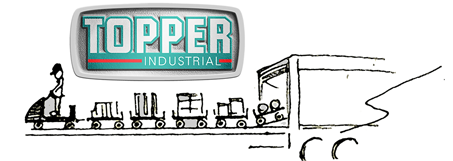In a few weeks at ProMat in Chicago the reasons for rapid Fork Truck Free (FTF) growth in North America will be carefully examined. There are some basic misconceptions about fork truck free.
Fork truck free does not always mean ZERO fork trucks in a manufacturing plant or distribution center. In fact, it quite often refers to minimal fork truck use, only allowed at receiving or shipping. This minimal use may include adding a at cart load/unload area. This limited use is actually prevalent and may be the start of a journey to becoming totally fork truck free.

100% Fork Trucks Free means no fork trucks in the plant. Everything is delivered to plants in trucks on carts. According to Ed Brown, CEO and Founder of Topper Industrial, “The goal doesn’t have to be fork truck elimination, but reduction is key.Brown suggested there are several key reasons that the FTF movement is thriving in North American Material Handling. Ultimately the proven benefits include productivity, flexibility, process stability, and inventory reduction. Additional benefits include earlier quality identification, reduced costs, improved safety, and fully utilized lean manufacturing compatibility.
Safety is driving momentum for fork truck free environments. Although training and legislation are instrumental in managing some degree of risks associated with forklifts, statistics reveal numerous accidents occur every year, providing reason for greater acceptance of forklift-free environments. This motivation towards forklift-free leads the way to adopting a more efficient form of transport–vision guided vehicles (VGVs)–favorably driving benefits beyond safety and profitability.
To protect workers, agencies in the United States like OSHA (Occupational Safety and Health Administration) provide analysis, research and prevention information, which policy makers use to regulate workplace safety and health. Various groups focus on standardized training and encourage continuous process improvements in workplace safety. Even with legislation and training enforcement, there is no evidence that these preventative methodologies have verifiable best practices and safe behaviors among forklift operators globally. Without evidentiary data to support these prevention techniques, companies concerned with safety are proactively seeking alternatives to forklifts with vision guided vehicles and forklift-free environments.
According to Scott Stone, Marketing Manager at Cisco-Eagle, “Fork-free environments are inherently safer. Just the injury-to-incident rate tells you that. Forklifts cause just 1% of industrial accidents, but over 10% of industrial injuries. You still have to find safer ways to move palletized and heavy loads, but those methods are out there. At the very least, reducing the number of forklifts helps you operate safer, since you are training fewer drivers (meaning you can train them better). With a hundred annual deaths and 20,000 serious injuries every year, forklifts tend to be the most dangerous machinery in any industrial operation. There are risks with the various fork-free methods but they tend to be mitigated to a greater degree.”
Topper Industrial is offering an educational seminar at ProMat 2017, the largest expo for the manufacturing and supply chain industries from April 3-6, 2016 in Chicago, IL. The seminar will be offered twice. The seminar, titled, “Why the Fork Truck Free Movement is the North American 2017 Material Handling Trend,” is April 3, 2017 from 12:45 PM – 1:30 PM in Theater D and April 5, 2017 from 3:00 PM – 3:45 PM in Theater E.
Attendees will learn about the material handling industry trend of fork truck free environments. Participants will be educated on lean manufacturing and fork truck free practices. Insight into the new way of manufacturing will include definitions, example and benefits. Participants will gain perspective into the popularity surrounding lean manufacturing and fork truck free. Topics will include, but are not limited to: cost reduction, increased efficiency, increased productivity, safety benefits, and legislative influences. Participants will be given the first steps needed to start a fork truck free journey. The process of plant analysis will be explained and concluded with the many options available when considering a fork free truck environment. Real-life case studies and statistics will be shared.

